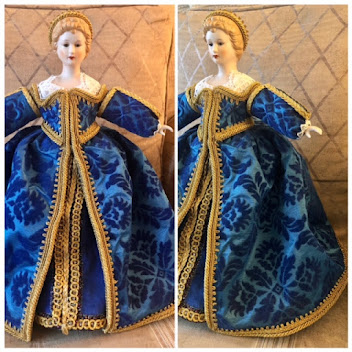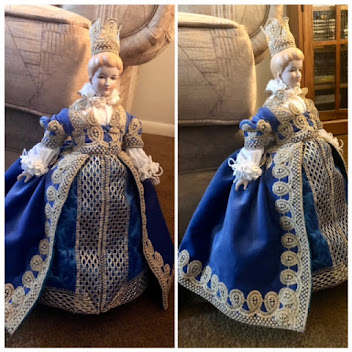When I am not working on dolls or making my own garb or garb for other people. One of my side arts and science’s project is fiber arts. When I originally learned to spin, I started on wool mostly of a Corridale breed of sheep. Which is an Australian breed eventually I learned to spin Marino, which is an Italian breed of sheep. More recently I’ve learned to spin shetland wall because it would’ve been available back in the 16th century and would’ve been a Scottish import.

Breed a sheep or something that happened after the timeframe I like to depict. Sheep are particularly bread for the kind of wool staple length of their fleece. They have to be shorn in the spring every year because the fleece does not fall out on its own due to the breeding. It’s the summertime now and even on Facebook marketplace I am seeing people who don’t sell their wool, trying to sell the fleeces unwashed to those who might actually use the wool. While I have purchased dirty fleeces to wash and then spin, it is very labor intensive. Some people also spin in the grease as it’s called and then wash the wool after it’s created into yarn. I’m still trying to figure out which version would’ve been more accurate to the 16th century. I very carefully store mine in a dry temperature control basement and if it is dirty wool, I put it in plastic to at least keep it from making other surfaces greasy.

After I had truly gotten comfortable with spinning wool. I want to try other fibers to see how they behaved. Next moving onto flax as that was one of the more common fibers in the 16th century. This was normally used as your base layer of clothing against your skin. Regardless of social economic status, you were wrapped in linen when you were a baby and wrapped in a line shroud when you were dead. So this clothing made from plants was ubiquitous in the human experience. I also found out that there is other plants besides flax that can be used to make linen fabric. Nettle or known as stinging nettle, bast fibers of the stem are harvested set to dry and then soaked to allow the outer shell to rot and the fibers to be released. Allowed to dry again and then manually beaten to slough off the outer shell of the stem. Bast fibers are the material that soaks up moisture, and brings it to the leaves and the top of the plant to allow photosynthesis. Through researching the history of plant fibers, I found out that there are many other plants that can be used to create fabric. Cotton, of course is the material around the seed pod. Jute, hemp, rayon known as cellulose, are all bast fibers some are more processed than others to create the necessary fibers for spinning into yarn. There are plenty other plant fibers that can be used to create fabric and be spun into yarn. It was a very interesting to research from horticultural background, to find the various plants species that can be used for creating fiber for clothing production. Wetting the plant material does help release some naturally occurring mucus that the plant uses to hold together that also will hold the yarn fibers together. This was a very interesting discovery while I was working with the various different kind of plant fibers

The most recent type of fiber I have been using is silk. I was finding the process of spinning, this fiber a bit more challenging. As the spindles I had were much larger and heavier, and were not allowing the fibers to pull apart as easily. I was able to learn from a fellow SCA person that I needed a smaller spindle so it’s fun faster to twist the fibers quicker. Which allowed me to draft the silk into the desired thickness and create a continuous unbroken thread. Which is always the goal when spinning to create a continuous unbroken thread the least amount of joins creates a very strong finish product. I’m noticing with silk in particular that I have to be very mindful of the tension when a join is present so it does not fall apart when I am trying to place it on the spindle for the next fibers to be drawn.
Currently, I am spinning some silk handkerchiefs in multi colors to get the hang of the manual spinning process. So far so good I’m hoping that eventually I can create my own silk threads for sewing and embroidery from my silk spinning. Even if I’m able to weave a little bit for my own use would also be nice as well. It would end up being more narrow work than yardage of wider fabric.
Also something to do while people are at Pennsic war For the next two weekends.
Mairin









No comments:
Post a Comment